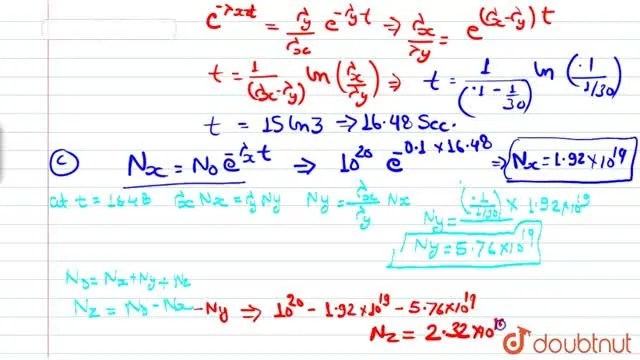A radioactive nucleus X decays to a nucleus Y with a decay constant λX=0.1s−1, Y further decays to a stable nucleus Z with a decay constant
λY=1/30s−1. Initially, there are only X nuclei and their number is N0=1020. Set up the rate equations for the populations of X, Y and Z. The population of Y nucleus as a function of time is given by NY(t)={N0λX/(λX−λY)}[exp(−λYt)−exp(−λXt)].
Find the time at which NY is maximum and determine the population X and Z at that instant.
The correct Answer is:A, D
(a) Let at time t=t, number of nuclei of Y and Z are NY and NZ. Then,
Rate equations of the populations of X, Y and Z are
(dNXdt)=−λXNX …(i)
(dNYdt)=λXNX−λYNY…(ii)
and (dNZdt)=λYNY...(iii)
(b) Given, NY(t)=N0λXλX−λY[e−λYt−e−λXt]
For NY to be maximum
dNY(t)dt=0
i.e λXNX=λYNY ...(iv) [from Eq. (ii)]
or
λX(N0e−λXt)=λYN0λXλX−λY[e−λYt−e−λXt]
or λX−λYλY=e−λYte−λXt−1
λXλY=e(λX−λY)t
or (λX−λY)t1n(e)=1n(λXλY)
or t=1λX−λY1n(λXλY)
Substituting the values of λX and λY, we have
t=1(0.1−1/30)1n(0.11/30)=151n(3)
or t=16.48s
(c) The population of X at this moment,
NX=N0e−λXt=(1020)e−(0.1)(16.48)
NX=1.92×1019
NY=NXλXλY [From Eq. (iv)]
=(1.92×1019)(0.11/30)
=5.76×1019
NZ=N0−NX−NY
=1020−1.92×1019−5.76×1019
NZ=2.32×1019
Related Playlists
- BOOK - DC PANDEY ENGLISHCHAPTER - MODERN PHYSICS - 2EXERCISE - Example Type 24videos
MODERN PHYSICS - 2
- BOOK - DC PANDEY ENGLISHCHAPTER - MODERN PHYSICS - 2EXERCISE - Miscellaneous Examples9videos
MODERN PHYSICS - 2
- BOOK - DC PANDEY ENGLISHCHAPTER - MODERN PHYSICS - 2EXERCISE - Level 2 Subjective10videos
MODERN PHYSICS - 2
- BOOK - DC PANDEY ENGLISHCHAPTER - MODERN PHYSICS - 1EXERCISE - Level 2 Subjective23videos
MODERN PHYSICS - 1
- BOOK - DC PANDEY ENGLISHCHAPTER - NUCLEIEXERCISE - C MADICAL ENTRANCES GALLERY46videos
NUCLEI
Similar Questions
Nucleus A decays into B with a decay constant λ1 and B further decays into C with a decay constant λ2 . Initially, at t = 0, the number of nuclei of A and B were 3N0 and N0 respectively. If at t = t0 number of nuclei of B becomes constant and equal to 2N0, then
View SolutionThe decay constant (λ) for radioactive decay is independent of
View SolutionNuclei of a radioactive element X are being produced at a constant rate K and this element decays to a stable nucleus Y with a decay constant λ and half-life T1/3. At the time t=0, there are N0nuclei of the element X.
The number NY of nuclei of Y at time t is .View SolutionNuclei of a radioactive element X are being produced at a constant rate K and this element decays to a stable nucleus Y with a decay constant λ and half-life T1/2. At the time t=0, there are N0nuclei of the element X.
The number NX of nuclei of X at time t=T1/2 is .View SolutionA radioactive substance A having N0 active nuclei at t=0, decays to another radioactive substance B with decay constant λ1. B further decays to a stable substance C with decay constant λ2. (a) Find the number of nuclei of A,B and C time t. (b) What should be the answer of part (a) if λ1>>λ2 and λ1<<λ2
View SolutionNucleus A decays to B with decay constant λ1 and B decays to C with decay constant λ2. Initially at t=0 number of nuclei of A and B are 2N0 and N0 respectively. At t=to, no. of nuclei of B is 3N02 and nuclei of B stop changing. Find t0?
View SolutionAt time t=0N1 nuclei of decay constant λ1&N2 nuclei of decay constant λ2 are mixed. The decay rate of the mixture at time 't' is:
View SolutionA stable nuclei C is formed from two radioactive nuclei A and B with decay constant of λ1 and λ2 respectively. Initially, the number of nuclei of A is N0 and that of B is zero. Nuclei B are produced at a constant rate of P. Find the number of the nuclei of C after time t.
View SolutionTwo radio active nuclei X and Y decay into stable nucleus Z
X→Z+2α+β−
Y→Z+α+2β+
if Z1 and Z2 are atomic numbers of X and Y thenView SolutionA radioacitve nucleus is being produced at a constant rate α per second. Its decay constant is λ. If N0 are the number of nuclei at time t=0, then maximum number of nuceli possible are .
View Solution


